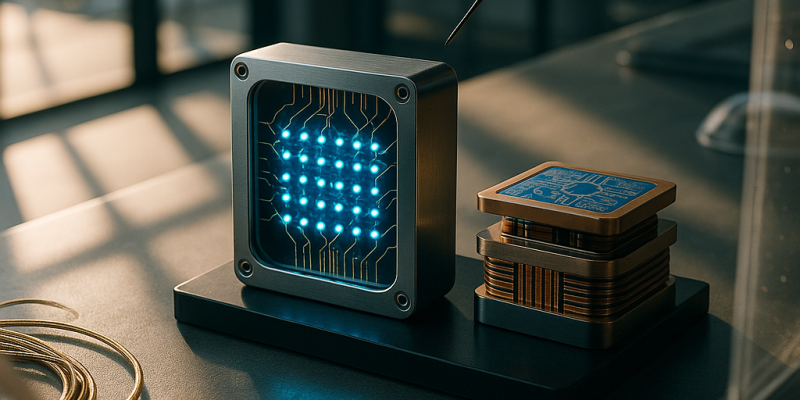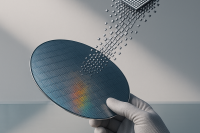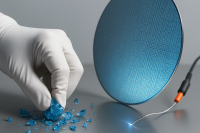Helios and IBM Roadmaps Make Fault-Tolerant Quantum Imminent
Published Nov 18, 2025
Think quantum advantage is still vaporware? This week’s hardware pushes say otherwise—and here’s what you need in 60 seconds: on 2025-11-06 Quantinuum launched Helios: 98 barium‐ion physical qubits delivering 48 error‐corrected logical qubits with single‐qubit fidelity 99.9975% and two‐qubit 99.921%, plus DARPA picked Quantinuum for Stage B of the Quantum Benchmarking Initiative to validate its Lumos-to‐2033 roadmap. On 2025-11-12 IBM unveiled Loon (a pathfinder for error‐correction architectures) and announced Nighthawk for end‐2025, which it says could beat classical machines on select tasks by late 2026 and aims for useful systems by 2029. Why it matters: error correction is moving from theory into hardware, changing timelines for customers, investors, and security. Watch Helios’ real workloads, DARPA’s evaluation, Nighthawk benchmarks and Loon’s architecture next.
IBM's Nighthawk and Loon Fast-Track Quantum Advantage by 2026
Published Nov 16, 2025
On 2025-11-12 IBM announced two quantum processors—Nighthawk (120-qubit, 218 tunable couplers, ~30% more circuit complexity than Heron) and experimental Loon (long‐range couplers, multi-layer routing, reset capabilities)—and set targets to demonstrate quantum advantage by end‐2026 and fault‐tolerant quantum computing by 2029. Nighthawk aims to run 5,000 two‐qubit gates by end‐2025, 7,500 in 2026 and 10,000 in 2027; qLDPC decoding latency has dropped below 480 ns (≈10× faster), and migration to 300 mm wafer fabrication at Albany NanoTech doubled R&D speed and increased chip complexity tenfold. These coordinated hardware, fabrication and decoding gains tighten timelines for demonstrable advantage and scalable QEC, with direct implications for customer roadmaps, developer priorities and investor decisions; near‐term milestones to watch are Nighthawk public deployments in Q4 2025, benchmark results in 2026, and scaled QEC demos through 2027–2029.
IBM's Nighthawk and Loon Propel Quantum Advantage Toward Fault Tolerance
Published Nov 16, 2025
At its Quantum Developer Conference on 2025-11-12, IBM unveiled hardware, software and fabrication advances: Nighthawk (120 qubits, 218 tunable couplers, ~30% more circuit complexity vs Heron) aiming for circuits of 5,000 two‐qubit gates by end‐2025, 7,500 by end‐2026 and 10,000 in 2027; and Loon, an experimental chip with long‐range couplers, routing layers and qubit‐reset gadgets aligned to IBM’s fault‐tolerance roadmap for 2029. IBM also reported a qLDPC-based classical decoder performing syndrome decoding in under 480 ns (one year early), introduced a C/C++ API for Qiskit that can cut error‐mitigation costs by >100×, and moved to 300 mm Albany NanoTech wafers to double R&D speed and raise chip complexity tenfold. Expect public Nighthawk access late‐2025/early‐2026, community-verified advantage checks in 2026, and logical‐qubit demonstrations through 2027–2029.
IBM’s Loon Chip Signals Rapid Path to Fault-Tolerant Quantum Computing
Published Nov 16, 2025
On 12 November 2025 IBM announced the experimental Loon chip, which uses a cellular‐systems‐derived error‐correction approach and aims to help deliver useful quantum computers by 2029; alongside it IBM unveiled Nighthawk, slated for external research access by end‐2025 and expected to outperform classical computers on some tasks by late‐2026. About a week earlier IBM showed a quantum error‐correction algorithm running on AMD FPGAs at speeds 10× faster than demanded by performance needs. These developments matter because Loon’s design and FPGA integration could lower logical error rates and reduce the physical‐qubit overhead, accelerating timelines and pressing software, algorithm and infrastructure readiness. Immediate milestones to watch are Nighthawk public benchmarks in late‐2025 and external quantum‐advantage demonstrations by late‐2026.
1 ms Superconducting Qubit: Princeton's Tantalum Breakthrough Accelerates Fault-Tolerant Quantum Computing
Published Nov 16, 2025
On November 5, 2025, a Princeton University team led by Andrew Houck, Nathalie de Leon and Robert Cava reported in Nature a superconducting qubit made from tantalum on high‐purity silicon with coherence exceeding 1 ms—about three times longer than prior lab best (0.3–0.4 ms) and roughly 15× higher than many current processors. Longer coherence reduces error‐correction overhead and allows more operations before errors, improving prospects for fault tolerance; related devices showed T1 up to 1.68 ms, Q ≈ 1.5×10^7 (peaks 2.5×10^7) and single‐qubit fidelities of 99.994% (MIT reported 99.998%). Princeton projects that integrating this design into processors like Willow could yield ~1,000× performance gains. Immediate outlook: raise two‐qubit fidelities (target >99.9%), demonstrate logical‐qubit break‐even in 2026, and standardize tantalum‐on‐silicon fabrication in early 2026.
SUPREME Pilot Line Catalyzes Industrial-Scale Superconducting Quantum Chips
Published Nov 12, 2025
On 2025-07-09 the EU selected the SUPREME consortium, coordinated by VTT (Finland) with 23 partners across eight member states, to run Europe’s first pilot line for industrial-scale superconducting quantum chip fabrication, with three main sites including Garching and Munich and a goal to deliver validated high-yield processes and shared process design kits (PDKs) by 2027. Simultaneously, market financing accelerated: on 2025-11-03 Xanadu announced a $3.6 billion SPAC merger to list on Nasdaq and raise close to $500 million including $275 million in PIPE, while Israeli startup Qedma closed a $26 million Series A to commercialize error-mitigation software that it says can scale usable circuit sizes up to 1,000×. These moves matter because they combine capital and manufacturing scale to improve hardware readiness, support domestic supply chains, and expose risks in yield, coherence, and cost; immediate milestones to watch are SUPREME's 2027 PDK delivery and Xanadu's use of proceeds.
Princeton’s Tantalum-Silicon Qubit Surpasses 1 ms, Propelling Practical Quantum Computing
Published Nov 12, 2025
On 2025-11-05 Princeton researchers reported a superconducting transmon qubit with coherence times exceeding 1 millisecond—three times prior lab records and nearly 15× the industry standard for large-scale processors—achieved by replacing aluminum-on-sapphire with tantalum circuits on high-quality silicon. The advance could make processors like Google’s Willow roughly 1,000× more reliable, directly improving error‐correction performance and amplifying benefits in larger systems; the design is compatible with transmon architectures used by major vendors. Key numbers: >1 ms coherence, 3× lab improvement, ~15× industry gap, and the 2025-11-05 announcement date. Remaining gaps include scaling coherence across arrays, integrating control/readout/error‐correction while preserving coherence, and ensuring fabrication yield and reproducibility. Immediate outlook: research labs will likely adopt tantalum‐silicon testbeds, industry may revise roadmaps, and funding/policy could shift toward materials and fabrication efforts.





